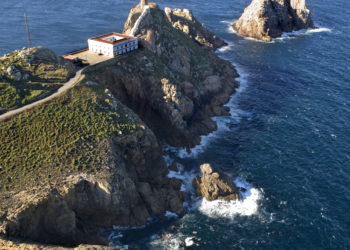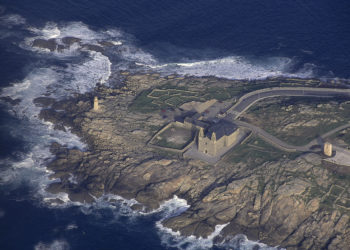COSTA DA MORTE
It covers the coastal area between Cabo Fisterra and the municipality of Malpica de Bergantiños. Its name comes from the steepness of its coasts, the harsh sea that surrounds it and the countless shipwrecks it has witnessed. The town and cape of Fisterra, End of the Earth, is for many pilgrims the true end of the Camino de Santiago. The area stands out for its traditions and countless legends, mostly linked to the sea. Our route will take you to the Costa da Morte through Muros and Carnota, an essential visit to delve into Galician customs and traditions.
An hour and a half separate Santiago from the seaside town of Muros, an important fishing center that maintains its cobbled and arcaded streets, which formerly served to protect fishing utensils or markets selling seafood. Leaving Muros we head along the AC-550 towards Carnota, where one of the largest Galician granaries is located, forming part of a beautiful architectural complex made up of the granary, the rectory and the church. Carnota also has the longest beach in the Galician community with 6 km of virgin sand. Bordering the coast we will reach Ézaro and its viewpoint, which is accessed by a narrow winding road. The climb is worth it. From there we will contemplate the waterfall and an impressive panoramic view of the coast.
Its name comes from the steep banks and the harsh sea that surrounds it.
Fisterra is half an hour away along the coast. Considered by the Romans to be the westernmost point in the known world, the Cape is the place where many pilgrims finish their Camino. In the summer months it is not surprising to find large groups of pilgrims there waiting for the sunset in the evening. Its lighthouse has saved lives since its construction in 1853. And it is there where tradition locates the magical Ara Solis, an altar raised as a tribute to the sun that rushes into the sea between great flames.
Once in Fisterra it is worth visiting Langosteira Beach. Far from the waves and wind that open sea beaches are subjected to, Langosteira is characterized by its calm and clean waters as well as the quality of the sand. In the northern part there is a curious cross that seems to preside over the sandy area, called Cruz de Baixar. The coast is a place for fish and seafood.
From Fisterra you have to go to Muxía, another of the great centers of tradition and religiosity in Galicia, with its Sanctuary and Pedra de la Virgen de la Barca. The Pedra de Abalar is in fact one of the most beautiful traditions of the Community. It is a large flat stone, located above the sea, which due to its placement can be easily moved with the weight of one’s own body. Anthropology attributes this rite the capacity for healing or initiation.



